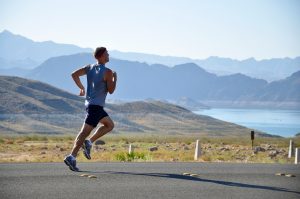The Dreaded Side Stitch
Most runners know all too well the discomfort of the notorious side stitch. There’s nothing worse than that sharp pain “under the ribs” creeping up out of no where to ruin what would otherwise be a perfectly great run.
The current term used to describe this side-ache is Exercise-Related Transient Abdominal Pain (or ETAP). It is defined as a well-localized pain that may occur in any region of the abdomen but is most common in the side of the mid-abdomen.

Although widely recognized as a problem for runners, ETAP commonly occurs during a variety of other activities. A study headed by Darren Morton, an exercise physiologist from the University of Newcastle and one of the leading researchers in this area, found that sixty-one per cent of athletes reported experiencing ETAP in the past year while participating in their selected sport. This included a variety of team sports, swimming, and horseback riding. It is interesting to note that ETAP has not been found to be as prevalent in cycling and rowing, leading experts to believe that this condition is associated more with activities involving repetitive up-and-down or twisting torso movement.
Most people tend to experience ETAP in the same area every time and will usually experience pain in the upper or lower torso regions or either side of the mid-abdomen. However, pain most often occurs on the right side. ETAP is also occasionally accompanied by pain in the shoulder region and has been described as “shoulder tip pain.”
 No matter where or how the pain occurs most individuals agree that ETAP is detrimental to performance. In fact, many people are forced to either reduce their activity level or stop entirely until the pain subsides, making a side stitch just as bad, if not worse, than any other injury. For this reason, the cause and best treatment of ETAP has become a hot topic for active individuals.
No matter where or how the pain occurs most individuals agree that ETAP is detrimental to performance. In fact, many people are forced to either reduce their activity level or stop entirely until the pain subsides, making a side stitch just as bad, if not worse, than any other injury. For this reason, the cause and best treatment of ETAP has become a hot topic for active individuals.
Current Theories
Although the exact cause of ETAP is largely unknown, there are several likely theories. The following are some of the more recent ones:
- Diaphragmatic ischemia (lack of blood flow to the diaphragm muscle)
Traditionally, diaphragmatic ischemia has been the most widely accepted cause of ETAP. Defined as reduced blood supply to the diaphragm muscle (the primary muscle used in breathing), the theory proposed that when other muscles in the body are working hard during activity, blood is either shunted from the area of the diaphragm to the working muscles or is blocked due to constriction or obstruction of the blood vessels supplying the diaphragm. This would lead to insufficient oxygen delivery and resulting pain.
Note: This is now one of the less-accepted theories.
- Stress on peritoneal ligaments
 Peritoneal ligaments support the internal organs below the diaphragm and some attach directly to the diaphragm itself. It is thought that as the internal organs, such as the liver, stomach, and spleen, bounce up and down, they tug at the diaphragm muscle, causing irritation and possibly even cramping of the muscle. This theory could explain the instance of ETAP in horseback riding, as the jolting activity could cause excessive stress on these ligaments. This could also explain why side stitches more often occur on the right side of the abdomen, since the liver, which is the heaviest organ in the abdomen, is located in this region.
Peritoneal ligaments support the internal organs below the diaphragm and some attach directly to the diaphragm itself. It is thought that as the internal organs, such as the liver, stomach, and spleen, bounce up and down, they tug at the diaphragm muscle, causing irritation and possibly even cramping of the muscle. This theory could explain the instance of ETAP in horseback riding, as the jolting activity could cause excessive stress on these ligaments. This could also explain why side stitches more often occur on the right side of the abdomen, since the liver, which is the heaviest organ in the abdomen, is located in this region.
- Irritation of the parietal peritoneum
This more recently proposed cause of side stitches suggests that pain does not originate from muscle cramps at all but occurs due to local irritation of tissues that surround the abdomen and organs. Specifically, the abdominal wall and pelvic cavity are lined in layers of tissue called parietal peritoneum. This parietal peritoneum also encompasses a majority of the organs in the abdominal cavity. It is thought that localized pain occurs when there is friction between the layers. A full stomach (due to food, fluid, or gas) or a reduction in fluid between the layers may cause this friction.
Because the parietal peritoneum extends throughout the abdomen this could explain why ETAP can occur in various sites throughout the abdomen. Also, the portion of the parietal peritoneum situated immediately below the diaphragm is supplied by the phrenic nerve. Branches of this nerve also supply areas of the shoulder, which could explain why radiating pain in the shoulder may sometimes accompany a side stitch.
- Irregularities in spinal posture
The thoracic area of the spine consists of twelve vertebrae that extend from the neck to the mid-back. This is the area of the spine that attaches the body’s twelve ribs. Increased instances of ETAP have been found in individuals who have increased kyphosis (spine is bent forward around the shoulder and upper back region) putting more pressure on the joints in this region. In fact, the feeling of a side stitch can often be produced when pressure is manually placed on specific joints in the thoracic region in individuals who are prone to side stitches. This occurs because several nerves arising from this region of the spine supply the front abdominal region. It is likely that these nerves may be irritated when the spine is excessively compressed in specific areas. Individuals who have joints in the thoracic spine showing excessive or limited motion have also been found to be more likely to develop ETAP.
-
 Hyperextension of lower back during downhill running
Hyperextension of lower back during downhill running
Hyperextension (bending backwards) may also be a contributing factor and accounts for the perception that bending forward relieves ETAP. Many runners will hyperextend their back when running downhill. This position in addition to the jolting movement of downhill running may provoke pain.
Note: Cycling is performed in a flexed (bent over) position with little torso movement. This may explain why cyclists are less likely to experience ETAP.
Tips on Relieving a Side Stitch
What should you do if you commonly experience debilitating side stitches? Here are a few good tips:
- Change breathing patterns
It is common for runners to step in time with their breathing. In fact, it has been found that many runners form an unconscious habit of breathing out on the same leg all of the time. One of the most popular striding-breathing patterns is two to one; meaning that two complete strides are taken for each breath in and each breath out. This produces asymmetrical stresses on the body.
When you inhale, your lungs fill with air as your diaphragm contracts downward. This downward contraction increases pressure and stability in the abdominal cavity. This is a good thing. Conversely, when you exhale, the diaphragm relaxes and springs upward, leaving more room for the organs to potentially “bounce.” So, if a person fully exhales with the same foot strike every time, the jolting action of the organs is dominant on one side and causes an asymmetric pressure on the abdominal and pelvic walls.
This may indicate why side stitches are more common on the right side of the torso. The liver, which is the heaviest organ in the abdomen, is located on the right side of the abdomen. It may therefore create a greater organic jolting action during exhalation.
TIP: When a stitch strikes, change your breathing pattern so that the leg on the opposite side of the body from the stitch is the one that hits the ground at the end of an exhalation.
TIP: Once in a while change breathing from one side to the next to better equalize stress.
- Fortify your diaphragm with belly breathing
A stronger and more flexible diaphragm will be better able to withstand and move with the organs of the abdomen. Belly breathing can help do this.
TIP: To belly breathe, lie on your back on the floor and place a set of heavy books on your stomach. Try to raise the books when you breathe in and drop when you breathe out. After you are proficient with this exercise, try to use this method of breathing as you run. Note: it takes time to learn, so be patient.
-
 What, when, and how much you eat or drink before activity
What, when, and how much you eat or drink before activity
Drinking too much liquid too fast has been found to be a significant cause of ETAP. It is also important to note that while taking in larger quantities of water has been found to provoke ETAP, dehydration has also been shown to cause it as well. Since either drinking too much or too little can cause ETAP, it is important to hydrate within an optimal range.
The composition of the beverage has also been shown to affect instances of ETAP. Beverages with high caloric content, high particle concentration, large volume (taken at once), and a high fluid acidity can all slow gastric emptying. This will lead to an increase in gastric (stomach) contents and greater tension on the supportive visceral ligaments, giving rise to symptoms of ETAP.
The good news is that if the same beverage is consumed on two separate occasions, instances of ETAP and bloating are lower on the second occasion.
TIP: Try to avoid fruit juices and beverages high in carbohydrate (sugar) concentration prior to and during exercise.
TIP: Follow product mix directions for water addition amount when using sport drinks for activity. Some individuals find that they feel even better when they dilute their sport drink by adding additional water.
TIP: Because symptoms associated with drinking carbohydrate beverages decrease with repetition, try practicing fluid ingestion during practice runs.
TIP: Avoid carbonated beverages during activity.
-
 Increase core strength
Increase core strength
Athletes with a strong core seem to have a much lower risk of developing a side stitch. Although it is not known why, it may be that increased trunk and pelvic muscle tone helps to support internal organs and keeps them from jostling up and down quite as much.
TIP: Focus on strengthening all the core musculature.
- Ensure proper function of the thoracic spine
A regular visit to a local chiropractor for adjustments or mobilizations to the thoracic spine may decrease the frequency or severity of side stitch pain in some patients affected by thoracic spine pain referral.
- Training will likely effectively decrease instances of ETAP
Typically, symptoms decrease the more you run. Keep the faith!
- Visit your physician
If symptoms persist, visit a health-care professional to rule out other syndromes that may lead to symptoms similar to ETAP.
This post was originally published as an article in IMPACT magazine September 24, 2008.
About the Authors
Amy Barnett is a gait analysis specialist and the director of Stride Evolutions in Calgary, Alberta. She was a three-time all-Canadian varsity track and field athlete and Canada Summer Games silver medalist.
Dr. Uchacz, clinic director of Chiropractic Performance and Sports Therapy Centre in downtown Calgary, Alberta, is a chiropractic sports specialist, certified strength and conditioning specialist, and president of the College of Chiropractic Sports Sciences (Canada).
